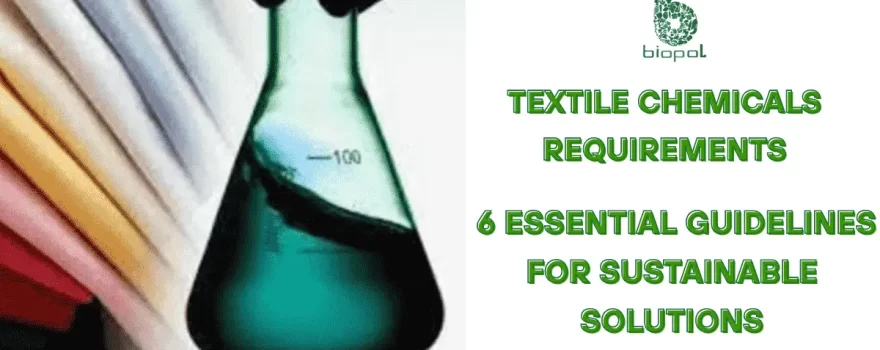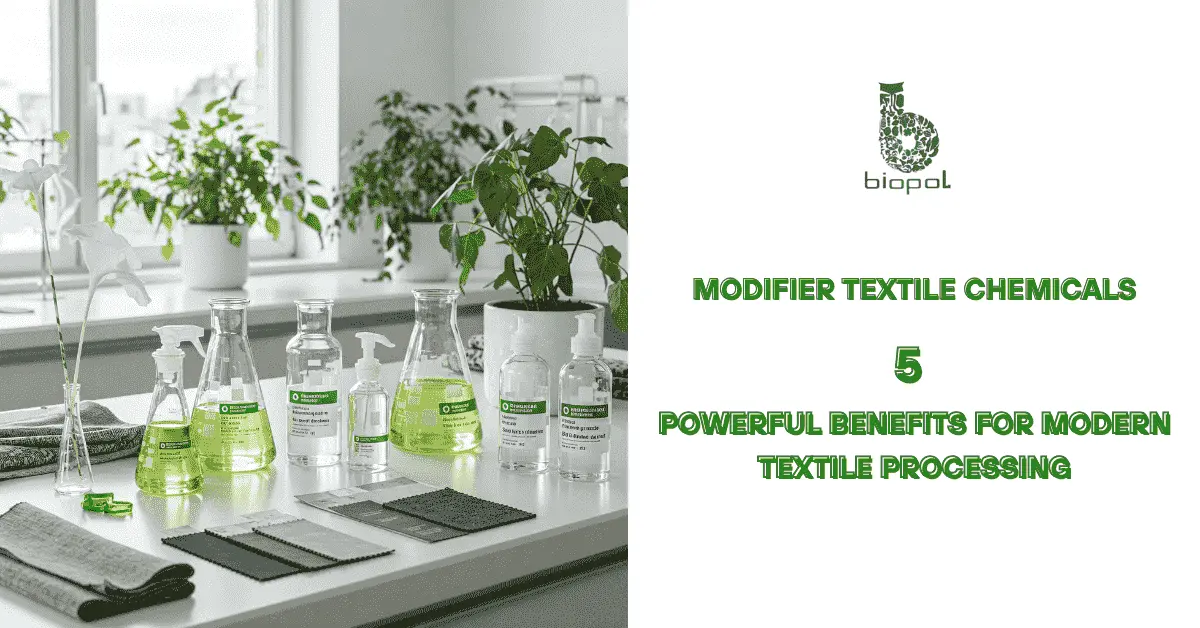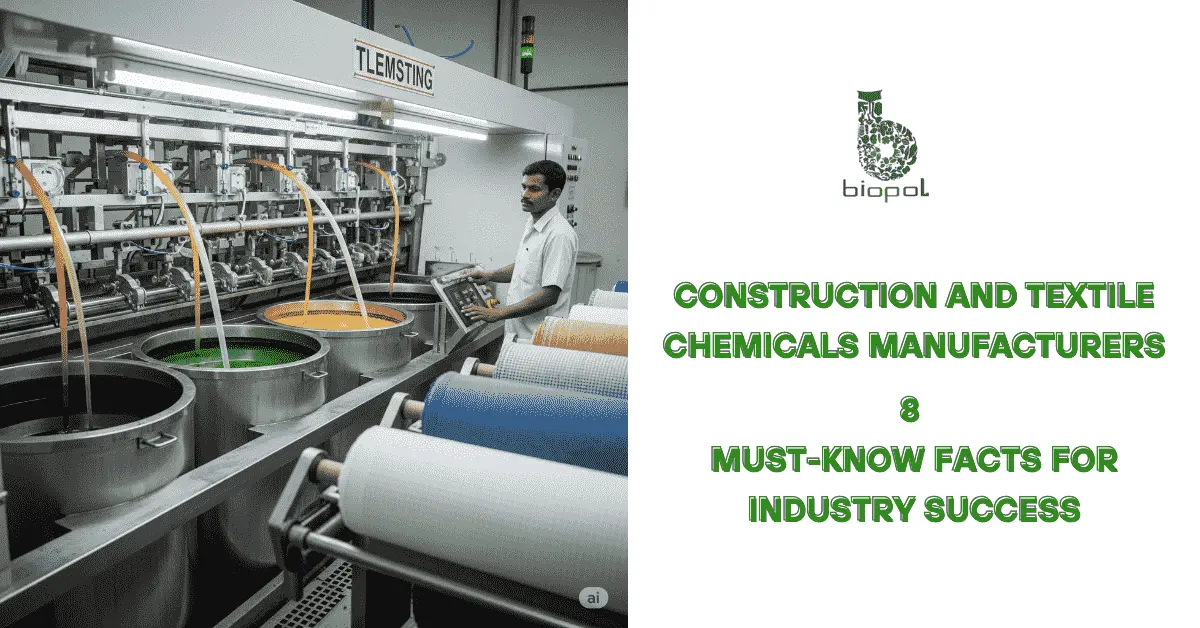
Textile Chemicals Requirements are crucial to be understood by the modern textile industry, to ensure sustainable growth for their business. The usage of textile chemicals has evolved dramatically over time. Today, consumer demand for high-performance, sustainable, and innovative fabrics drives continuous advancements in textile chemistry, thus making it all the more important for us to understand how to meet these high expectations, while not compromising on the requirements of a strong manufacturing foundation.
Table of Contents
What are the Textile Chemicals Requirements?
The important requirements for any manufacturing process, and also for textile chemicals is as below:
- Safety – The product must be safe to use, the workers must get a safe environment to work, and chemicals/waste material must be treated with utmost safety.
- Compliance – All legal compliances must be in place, environmental regulations followed, and accurate testing put in place.
- Efficiency – Quality control should be optimum, with research and development supporting production all the way.
- Sustainability – Waste minimisation protocols to be in place, with efficient use of water and other resources.
Importance of Textile Chemicals Requirements
- Understanding the textile chemicals requirements is vital for manufacturers to ensure compliance and sustainability, thus enhancing their market appeal.
- The dynamic and competitive nature of the industry requires that textile chemicals requirements are understood and followed for survival.
- It is essential to stay informed about the latest updates to maintain competitive advantages.
- Companies must align their practices with the evolving textile chemicals requirements to ensure product innovation, profitability, and market relevance.
- Understanding the various textile chemicals requirements allows manufacturers to tailor their processes to meet customer needs effectively.
Solutions to the Challenges of Requirements
- Use renewable, plant-based chemicals.
- Implement water-saving technologies like closed-loop systems.
- Minimize waste through efficient chemical use.
- Develop biodegradable, non-toxic chemicals.
Challenges to Meeting Requirements
- Higher costs of sustainable alternatives.
- Technological and scalability hurdles.
- Limited awareness among stakeholders.
Global Standards and Requirements
A framework of standards ensures the safety and quality of textile chemicals:
- Key Standards:
- REACH: EU regulation for safe chemical use.
- ZDHC: Eliminates hazardous chemicals globally.
- GOTS: Covers environmental and social criteria for organic textiles.
- Certification Processes:
- Third-party audits for compliance.
- Rigorous chemical testing for safety and performance.
- Transparent records of chemical usage and supply chains.
- Consumer Safety and Trust:
- Eco-labels inform consumers about sustainability and impact.
- Adherence to standards builds trust and market differentiation.
Commitment to these standards enhances sustainability, safety, and responsible practices in the textile industry.
What will the Future of Requirements Look Like?
- Smart Chemicals for Smart Textiles:
- Functional finishes: Self-cleaning, temperature regulation, and conductivity.
- Responsive materials: Adaptive textiles reacting to stimuli like light and moisture.
- Bio-Based and Recyclable Chemicals:
- Renewable resources: Use of plant-based and bio-derived chemicals.
- Biodegradable solutions: Chemicals designed for easy recycling and minimal environmental impact.
- AI in Chemical Development:
- Accelerates R&D: Speeds up discovery of sustainable chemicals.
- Predictive modeling: AI forecasts chemical properties for targeted research.
- Process optimization: Reduces waste and improves efficiency.
These advancements enhance textile functionality while promoting sustainability.
Conclusion: Aligning Requirements with Needs
- Key Takeaways: Textile chemicals are essential, selection criteria are crucial, sustainability is paramount, global standards ensure quality, challenges require proactive solutions, and innovations shape the future.
- The Road Ahead: Emphasis on eco-friendly chemicals, growth in smart textiles, integration of AI, and a focus on circularity.
- Call to Action: Manufacturers should embrace sustainable practices and invest in R&D, while policymakers should create supportive policies.
FAQs: Textile Chemicals Requirements
1. What chemicals are used in textiles?
Textile production involves a wide range of chemicals, including:
- Pretreatment chemicals – Sodium hydroxide (scouring), hydrogen peroxide (bleaching)
- Colorants – Reactive dyes, disperse dyes, vat dyes, acid dyes
- Finishing agents – Softeners, water repellents, flame retardants, wrinkle-resistant resins
- Auxiliaries – Surfactants, dispersing agents, emulsifiers, and leveling agents
These chemicals are essential for achieving the desired look, feel, and performance of fabrics.
2. What are the requirements for textile design?
To align with chemical processing, textile design must consider:
- Fiber compatibility – Designs must match chemical behavior of chosen fibers
- Colorfastness – Use of chemicals that ensure long-lasting color under washing or sunlight
- Functional goals – Designs should factor in finishes like water-repellency or antimicrobial coatings
- Sustainability – Preference for low-impact dyes and eco-friendly auxiliaries
- Regulatory compliance – Design must adhere to safety and environmental standards (e.g., REACH, OEKO-TEX)
3. What are the basics of textile chemical processing?
Textile chemical processing typically includes:
- Pre-treatment – Removal of natural impurities and preparation for dyeing
- Dyeing and printing – Application of color using appropriate chemical dyes
- Finishing – Chemical treatments for specific effects (e.g., softness, water resistance)
- Post-processing checks – Ensuring compliance with quality and environmental norms
Each step involves specific chemical formulations tailored to fabric type and end-use.
Also Read: Textile Chemicals: The Secret Sauce Behind Your Clothes

